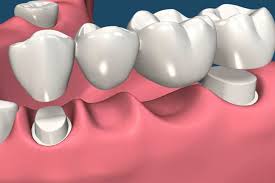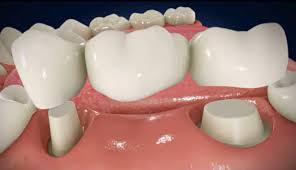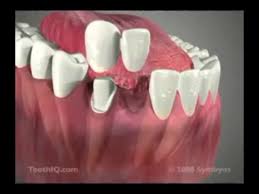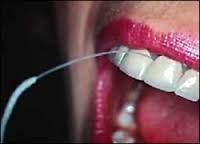What is a Dental Bridge?

Dental Bridge
Dental bridges are fixed dental prosthesises which are used to replace one or more missing teeth by joining the artificial tooth/teeth to adjacent teeth or even dental implants. The anchoring teeth are called abutments and the false teeth between are called pontics. A dental bridge can be made from many different materials including metal alloys, gold, porcelain, zirconium or even composite resin. A combination of materials is often used.
Dental bridges are a fairly affordable, low-risk and time-tested way to replace missing teeth in order to restore function and the aesthetics. Cosmetic Dentistry Advisor provides information regarding dental bridges as they are often a very important part of Cosmetic Dentistry. Due to advances in dental technology, bridges can be virtually indistinguishable from a person’s natural teeth.
Virtually anyone with missing teeth can be a candidate for a dental bridge, provided that they have good oral hygiene and their oral health is fairly good. If a person has gum disease, it should ideally be treated first. The teeth adjacent to the space must be structurally sound and strong enough to retain the bridge. If not, dental implants can be placed to retain the bridge.
Benefits of Dental Bridges
Great Aesthetics
Your smile can be restored be replacing a missing tooth with a bridge that matches the natural teeth exceptionally well and can hardly be distinguished from the natural teeth. In addition to that, the shape, angulations and color of the teeth on either side of the missing tooth, which will be used to support the bridge, can be improved in order to get a great aesthetic result.

Great Aesthetics
Comfortable and Not Removable
A bridge will feel like your own teeth. Unlike partial dentures, it doesn’t need to be taken out and cleaned. With a bridge, you will not need to be concerned about the teeth moving when you eat or speak.
Maintain the Shape of you Face
I often found that people who do not get along with removable dentures, do not use them, leaving the gap in their mouth. Unfortunately this means that there is no lip support in that area – impacting negatively on the aesthetic of their appearance.
Restore the ability to chew and speak
Replacing missing teeth will certainly make it much easier to chew food properly. Depending on which tooth is missing, tooth loss can often make it difficult to speak clearly. Some people also struggle to form the sounds properly when they are wearing dentures. When replacing missing teeth, especially front ones, it may improve speech.
Distribute Biting Forces Evenly
It is important to distribute biting forces evenly in the mouth as it helps to protect the other teeth, and prevent problems that may arise due to too much biting forces on them. It helps to stabilize the occlusion (way your teeth bite together) and prevent TM-joint problems.
Keeps Remaining Teeth in Position
When there is a gap between teeth for an extended period of time, teeth will tend to drift into that space. A dental bridge will keep the position of the teeth stable.
Protective
Crowning the teeth on either side of the tooth that needs replacing, as part of the bridge, can help to restore and protect them if they were broken or heavily filled.
Quick and Easy to Make
Compared to implants, bridges are easy as no surgery is required. For a person who is unable to undergo implant surgery for medical or other reasons, it is a great, less invasive alternative. It’s also relatively quick to get a bridge done as it usually only takes 2 appointments from start to finish. Even dentures usually require more appointments to complete.
Dental Bridges are Not Always Suitable
Unfortunately there are circumstances where a dental bridge may not be possible or advisable.
- Too expensive
- Medical conditions, e.g. if a person is unable to lie down for a relatively long appointment.
- Not enough space. If a tooth has been missing for a long time, other teeth may drift into the space, leaving too little space to replace the missing tooth.
- Multiple missing teeth. In some cases it may be better to replace them with a denture instead, especially if more tooth loss is expected. Extra teeth can easily be added onto partial dentures but not to a bridge.

Multiple Missing Teeth
- Periodontal disease. As periodontal disease may cause the supporting teeth to loosen, it is extremely important to treat the periodontitis first. If the supporting teeth are already quite loose, the extra lode from the bridge may cause these teeth to loosen to the point where they need extraction.
- Poor Oral Hygiene .

Poor Oral Hygiene
- Adjacent teeth perfectly healthy. As the adjacent teeth need to be prepared and cut down to a suitable shape in order to support a bridge, it is not ideal if these teeth are still perfectly healthy. In these cases an implant supported crown should be considered instead.

Healthy Teeth Adjacent to Space
- Last molar replacement. It is not ideal to have a bridge that is only supported on one side, especially if it is a molar, as molars need to be able to withstand very high forces during mastication. If the last molar must be replaced, an implant would be a better solution. As the last molar is not visible, it is often not necessary to replace it at all, especially if the person still has enough other teeth for comfortable chewing.
Types of Dental Bridges
Traditional Bridges
Traditional bridges consist of crowns on the teeth or implants on either side or the gap, with one or more false teeth (pontics) attached to them. They are the most common bridge type and are stable and durable.

Traditional Dental Bridge
Maryland Bonded Bridges
The replacement tooth is supported on either side by wings that are bonded to the existing teeth.

Maryland Bridge
Cantilever Bridges
A cantilever bridge is supported with only one adjacent tooth. This can be used when there are not suitable teeth on either side of the gap to support the bridge, provided that the biting forces on the pontic (replacement tooth) are not very high. The supporting tooth should be very strong and ideally have more or larger roots than the extracted tooth.

Cantilever Bridge
Oral Care after Dental Bridge placement
A Bridge can last for 15 years or longer, provided that emasculate oral hygiene is maintained. If a person doesn’t maintain good oral hygiene, the supporting teeth can get decayed. Gum disease may also become a problem and can lead to tooth-loss if not treated successfully.
It can be a bit challenging to clean thoroughly around and under the bridge. I would suggest that you visit your dentist or hygienist regularly for thorough cleaning and advice. Invest in a good quality electric toothbrush. I prefer sonic toothbrushes as it helps to loosen particles in hard to reach places.

Sonicare Toothbrush
Special floss can be used, which has a thin firm end and can thread through underneath the bridge.

Superfloss
Another great gadget to use is a water/air flosser which sprays compressed air and water droplets at high speed to clean between the teeth and in hard to reach areas.

Aquaflosser
Use a good quality toothpaste and mouthrinse twice daily and visit your dentist for regular check-ups.
Leave a comment
